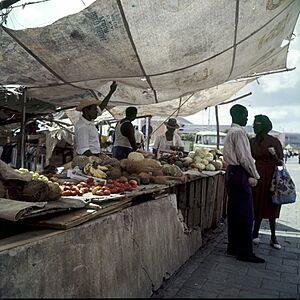Shade facts for kids
When the sun is shining brightly, you might look for a cool spot to stand or sit. This cool spot, where direct sunlight doesn't reach, is called shade. It's a place where something like a tree, a building, or an umbrella blocks the sun's rays, making it feel cooler and protecting you from too much sun.
What is Shade?
Shade happens when an object blocks the path of light, especially sunlight. Imagine you are outside on a sunny day. If you stand under a big tree, the tree's leaves and branches stop the sun's rays from reaching you directly. This area under the tree is in the shade.
Shade is important for many reasons:
- It helps keep things cool, which is great for people, animals, and plants on hot days.
- It protects you from the sun's strong ultraviolet (UV) rays, which can be harmful.
- It creates different lighting effects, making some areas darker than others.
Shade vs. Shadow
It's easy to confuse shade with shadow, but they are different!
- Shade is the area where direct sunlight is blocked. It's a cooler, darker area. For example, the area under an umbrella is in the shade.
- A shadow is the dark shape or outline that an object casts on a surface when light is blocked. It's the specific dark shape you see on the ground or a wall. For example, the dark shape of your body on the pavement when the sun is behind you is your shadow.
Think of it this way: The entire area under a big cloud is in the shade, but the cloud itself doesn't cast a sharp shadow on the ground. A person, however, casts a clear shadow.
Shade as a Color
The word "shade" can also mean a slightly different version of a color. When we talk about colors, a "shade" refers to a darker version of a base color. For example, if you add a little black to blue paint, you get a darker shade of blue.
On the other hand, if you add white to a color, you get a "tint." So, a light blue is a tint of blue, while a dark blue is a shade of blue. This idea helps artists and designers talk about the many variations of colors they use.
See also
 In Spanish: Shade para niños
In Spanish: Shade para niños


